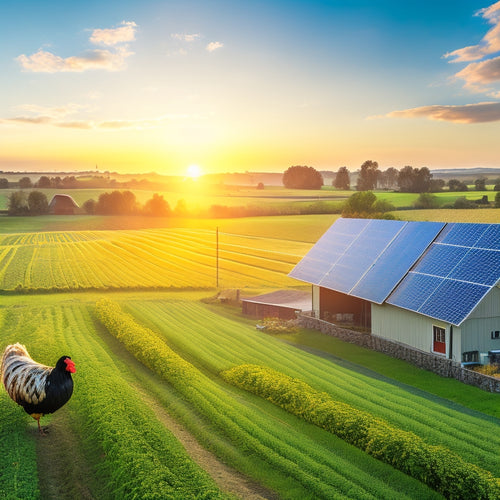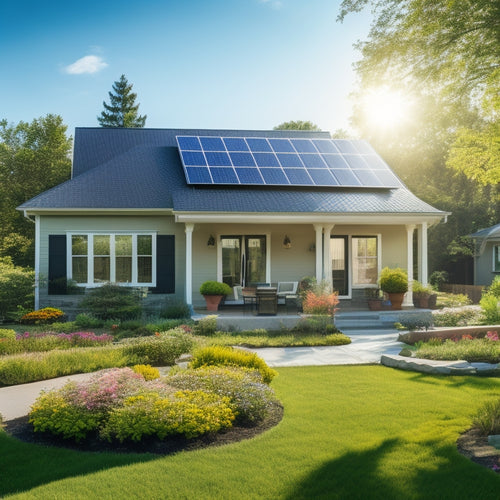
Top 10 Solar Panel System Prices Compared
Share
When comparing top commercial solar panel system prices, you'll find that the cost per watt can vary greatly, ranging from $2.25 to $3.50, depending on the system size, complexity, and brand, with total upfront costs for a 100-kilowatt system spanning from $45,000 to $175,000. Small business systems typically range from 10 kW to 50 kW, while larger installations offer economies of scale and lower costs per watt. You'll want to take into account installation costs, including labor fees, as well as government incentives like the Solar Investment Tax Credit. As you explore the top commercial solar panel system prices, you'll uncover more nuances that can make or break your investment.
Key Takeaways
• Commercial solar panel system costs range from $2.25 to $3.50 per watt, with total upfront costs varying greatly depending on system size.
• Small business systems typically range from 10 kW to 50 kW, with medium-scale commercial installations requiring informed decisions for successful installations.
• Installation costs include panels, inverters, mounting hardware, and labor fees, with annual maintenance contract costs ranging from $2,000 to $5,000.
• The cost of a 100-kilowatt system can range from $45,000 to $175,000, depending on the complexity of the system design and installation.
• Large commercial systems offer economies of scale and lower costs per watt, making them a more cost-effective option for businesses.
Average Cost of Commercial Systems
On average, a commercial solar panel system can cost anywhere from $2.50 to $3.50 per watt, which translates to a total upfront cost of $50,000 to $175,000 for a typical 100-kilowatt system.
When considering investing in a commercial solar panel system, understanding the financial benefits that come with it's crucial. One of the significant advantages is the solar incentives offered by the government. You can benefit from the Solar Investment Tax Credit (ITC), which allows you to claim a tax credit of 26% of the total system cost. This can greatly reduce your upfront cost. Additionally, you can take advantage of accelerated depreciation, which can provide additional tax savings.
With solar energy, you can also reduce your operating expenses by lowering your energy bills. By switching to solar, you can lock in a fixed energy rate, protecting you from rising electricity costs.
Small Business Solar Panel Prices
As a small business owner, you'll be pleased to know that installing a solar panel system can be a cost-effective way to reduce your energy expenses, with prices ranging from $2.25 to $3.25 per watt, depending on the system size and quality.
A well-designed solar panel system can meaningfully reduce your electricity bills, freeing up more resources for your business strategy. With the financial benefits of solar energy, you can reallocate your budget to focus on growth and expansion.
For small businesses, solar panel systems typically range from 10 kW to 50 kW in size. The total cost of the system will depend on the size and quality of the equipment, as well as the installation company you choose. On average, a 20 kW solar panel system can cost between $45,000 and $65,000.
However, with the financial benefits of solar energy, you can expect to recoup your investment in as little as 5-7 years. With the right business strategy, going solar can be a smart financial move for your small business.
Medium-Scale Commercial Installations
When you're considering a medium-scale commercial solar installation, there are several key factors to take into account.
You'll need to factor in the complexity of the system design, which can impact the overall cost. This involves considering the optimal placement of panels, inverters, and other components to ensure efficient energy generation.
You'll also want to think about the installation time frame, as this can affect your business's operations and revenue streams. Planning for any potential disruptions and coordinating the installation process with your daily activities is crucial.
Additionally, you'll need to project the energy output to guarantee the system meets your energy needs and provides a strong return on investment. This involves analyzing your historical electricity usage and future energy requirements to determine the system size and capacity needed for optimal performance.
Taking these factors into consideration will help you make informed decisions and ensure a successful medium-scale commercial solar installation.
System Design Complexity
Your medium-scale commercial solar panel installation's design complexity greatly impacts its overall cost, with more intricate system designs necessitating additional labor, materials, and engineering expertise.
As you consider your solar panel system, you'll need to weigh the benefits of a complex system architecture against the added expenses. A more complex design might allow for greater energy output, but it'll also require more sophisticated system monitoring and maintenance.
When evaluating system design complexity, you'll encounter design trade-offs. For instance, a system with more inverters might provide greater redundancy, but it'll also increase upfront costs. Conversely, a system with fewer, higher-capacity inverters might be more cost-effective, but it'll also introduce single points of failure.
As you navigate these trade-offs, consider your energy goals, budget, and operational requirements. By carefully balancing complexity and cost, you can optimize your solar panel system's design to maximize your return on investment.
Installation Time Frames
Medium-scale commercial solar panel installations typically require a more extensive installation time frame than smaller-scale projects. This process can take anywhere from several weeks to several months to complete, depending on factors such as system size, complexity, and labor availability.
As you plan your project, it's crucial to take into account the project timelines and crew logistics that will impact the installation process. You'll need to coordinate with your installation team to ensure that all necessary permits are secured, equipment is delivered on time, and labor resources are allocated efficiently.
A well-planned project schedule will help minimize delays and ensure that your system is up and running as quickly as possible. Be prepared to adapt to changes in your project timeline, as unexpected setbacks can arise.
Energy Output Projections
Accurately projecting energy output is vital for medium-scale commercial solar panel installations, as it directly impacts the system's financial viability and return on investment. You need to know how much energy your system will produce to make informed decisions about your investment.
Energy output projections involve analyzing various factors, including the system's size, panel efficiency, and local climate conditions. Climate modeling and energy forecasting are essential tools in this process. By using advanced climate models, you can accurately predict the amount of solar irradiance your system will receive, which in turn affects energy production.
Energy forecasting algorithms can then be applied to estimate the system's energy output over time. This information is critical for evaluating the system's potential return on investment and making informed decisions about your solar panel installation.
Large Commercial Solar System Costs
When considering large commercial solar system costs, you'll need to think about system size and cost.
As you explore installation options, keep in mind that larger systems typically require more complex installations, which can drive up costs.
Meanwhile, maintenance requirements will also impact your overall expenses, so make sure to factor these in as you plan your large-scale solar project.
System Size and Cost
As you explore large commercial solar panel systems, you'll find that system size and cost are intimately connected. Larger commercial solar panel systems, typically ranging from 500 kilowatts to several megawatts, come with higher upfront costs, but their economies of scale can lead to lower costs per watt. With larger systems, the cost per watt decreases as the system size increases, making them more cost-effective.
When evaluating system costs, it's essential to consider the cost breakdown. The total cost includes the cost of the solar panels, inverters, mounting hardware, installation, and other components.
A key factor in determining the overall cost is system efficiency, which affects the amount of electricity generated per watt. A more efficient system will require fewer panels to produce the same amount of energy, reducing the overall cost.
Installation and Maintenance
You'll need to factor in the costs of installation and maintenance when calculating the total expense of your large commercial solar panel system, as these expenses can add up quickly. Installation costs can vary depending on the complexity of the project, but on average, you can expect to pay between $0.50 to $1.50 per watt.
| Installation/Maintenance Task | Average Cost |
| Site visits for assessment and planning | $500 - $2,000 |
| Technician training for maintenance | $1,000 - $3,000 |
| Annual maintenance contract | $2,000 - $5,000 |
In addition to installation costs, you'll need to take into account ongoing maintenance expenses to consider that your system operates at peak performance. Site visits for assessment and planning can range from $500 to $2,000, depending on the complexity of the project. Technician training for maintenance can cost between $1,000 to $3,000. Finally, an annual maintenance contract can cost between $2,000 to $5,000. By factoring in these costs, you can get a more accurate estimate of the total expense of your large commercial solar panel system.
Government Incentives and Rebates
Government incentives and rebates greatly reduce the upfront cost of solar panel systems, making them more accessible to homeowners and businesses alike. As you consider investing in solar energy, it's crucial to understand the government-backed initiatives that can help offset the initial investment.
One significant incentive is the Solar Investment Tax Credit (ITC), which allows you to claim a tax credit of 26% of the total system cost. This can greatly reduce your tax liability, making solar energy a more affordable option.
Additionally, many governments have implemented green policies to encourage the adoption of renewable energy sources. These policies often include rebates, grants, and low-interest loans to support the shift to clean energy.
By taking advantage of these incentives, you can enjoy substantial savings on your solar panel system. For instance, the US Department of Agriculture offers grants and loans to rural communities to promote renewable energy development. Similarly, many states offer property tax exemptions or sales tax exemptions for solar panel systems.
Top Commercial Solar Panel Brands
When evaluating solar panel system prices, you'll likely come across several top commercial brands that stand out from the rest. These industry leaders are known for their high-quality products and innovative technology, which can impact the overall cost and efficiency of your solar panel system.
As you research, you'll want to explore brands that offer the best combination of quality, price, and performance.
Top Brands Compared
Comparing top commercial solar panel brands, including industry giants like Trina, Canadian Solar, and Hanwha Q CELLS, helps you identify the most suitable option for your specific needs and budget.
When evaluating these brands, consider factors such as their market share, brand loyalty, and market trends. For instance, Trina's strong brand loyalty stems from its commitment to innovation and quality, making it a popular choice among consumers.
On the other hand, Canadian Solar's extensive global presence and diverse product offerings have enabled it to stay ahead of market trends. Hanwha Q CELLS, with its focus on high-efficiency modules, has carved a niche for itself in the premium segment.
Industry-Leading Technology
You're likely looking for top commercial solar panel brands that offer industry-leading technology to maximize your energy output and reduce your carbon footprint. When it comes to harnessing the power of the sun, you want the best technology on your side. Top brands like SunPower, Panasonic, and Trina Solar are leading the charge with smart innovations that set them apart from the rest. Their cutting-edge technology enables higher energy yields, increased efficiency, and improved durability.
These industry leaders are constantly pushing the boundaries of what's possible with solar energy. They're investing in future developments like bifacial panels, perovskite cells, and advanced inverters that will elevate solar energy to the next level. With their commitment to innovation, you can expect even more efficient and cost-effective solutions in the years to come.
When choosing a commercial solar panel brand, look for those that prioritize research and development, ensuring you'll stay ahead of the curve and reap the benefits of the latest advancements. By partnering with industry leaders, you'll be well on your way to tapping into the full potential of solar energy and achieving a cleaner, more sustainable future.
Installation Costs and Labor Fees
What sets the price of a solar panel system apart is the varying cost of installation, which can range from $2,000 to $10,000 or more, depending on the complexity of the job and the installer's labor fees. When considering different solar panel systems, it's crucial to factor in these installation costs to get an accurate estimate of the total price.
Here are three key factors that can impact installation costs:
-
Site visits: The number of site visits required to assess your property's solar potential can add to the overall cost. Multiple visits may be necessary to evaluate a proper installation.
-
Labor laws: Compliance with local labor laws and regulations can influence labor fees. Installers must navigate these laws to ensure a smooth installation process.
-
Installer expertise: The level of expertise and certification of the installer can have a significant effect on labor fees. More experienced installers may charge higher rates, but they may also provide a higher quality installation.
Commercial Solar System Sizes Compared
When sizing up commercial solar systems, businesses typically opt for larger installations, ranging from 10 kilowatts to multiple megawatts, to maximize energy savings and returns on investment. This is because larger systems offer greater commercial viability and system scalability, allowing businesses to reduce their energy costs and increase their bottom line.
Here's a comparison of different commercial solar system sizes:
| System Size (kW) | Annual Energy Production (kWh) | Estimated Cost |
|---|---|---|
| 10 kW | 15,000 kWh | $30,000 - $40,000 |
| 50 kW | 75,000 kWh | $150,000 - $200,000 |
| 100 kW | 150,000 kWh | $300,000 - $400,000 |
| 250 kW | 375,000 kWh | $750,000 - $1,000,000 |
| 500 kW | 750,000 kWh | $1,500,000 - $2,000,000 |
As you can see, larger systems offer greater energy production and cost savings, making them a more attractive option for businesses looking to reduce their energy costs and increase their commercial viability. By investing in a larger system, you can maximize your returns on investment and achieve greater system scalability.
Energy Storage System Options
Your energy independence relies on integrating an efficient energy storage system with your commercial solar panel installation, as it enables you to store excess energy generated during the day for use during periods of low sunlight or at night. This means you can rely less on the grid and more on your own clean energy.
When selecting an energy storage system, consider the following key factors:
-
Battery Life: Look for a system with a long lifespan to minimize replacement costs and maximize your ROI.
-
Grid Connection: Make sure your system can seamlessly switch between grid power and stored energy, providing uninterrupted access to electricity.
-
Depth of Discharge (DOD): Opt for a system with a high DOD to maximize the amount of stored energy you can use.
Ongoing Maintenance and Support
Regular system checks and maintenance are vital to guaranteeing your commercial solar panel system operates at peak levels, prolongs its lifespan, and reduces the risk of unexpected downtime.
You'll want to schedule regular inspections to identify and address any issues before they escalate into major problems. This proactive approach will help you maximize energy production, reduce repair costs, and minimize system downtime.
When selecting a solar panel system provider, look for those that offer thorough maintenance and support packages. These packages often include regular inspections, priority customer support, and extended warranties.
Extended warranties, in particular, can provide you with peace of mind, knowing that you're protected against unexpected repair costs.
Be sure to review the maintenance and support options offered by each provider, as they can vary significantly. Some providers may offer more detailed packages, while others may charge extra for additional services.
Frequently Asked Questions
Can Solar Panels Be Installed on a Metal Roof?
You can install solar panels on a metal roof, as long as the metal material is compatible with the panel's mounting system, ensuring a secure and watertight seal to prevent water damage.
How Long Does a Commercial Solar Panel System Last?
You can expect a commercial solar panel system to last around 25-30 years, backed by warranty periods of 10-25 years, with regular maintenance schedules ensuring peak performance and extending its lifespan.
Are Solar Panels Resistant to Hail and Extreme Weather?
As you navigate the medieval battlefield of extreme weather, you'll find solar panels donning armor of durability, withstanding hailstorms and tempests like a knight in shining armor, boasting Storm Resistance and Weather Durability that'll make you feel liberated from grid tyranny.
Can I Install Solar Panels on a Rooftop With Skylights?
You can install solar panels on a rooftop with skylights, but you'll need to take into account roof obstruction and skylight placement to guarantee a safe, efficient installation that maximizes energy production.
Do Solar Panels Work Efficiently in Shaded Areas?
"As you navigate the path to solar liberation, you'll find that shaded areas can be a hurdle. Tree shadows and cloud cover can reduce efficiency, but don't let that dim your solar dreams - there are ways to optimize your system for maximum energy harvest."
Related Posts
-

Solar Power Advantages for Rural Communities
Solar power presents numerous advantages for rural communities. You can greatly reduce energy costs, potentially by u...
-

Eco-Friendly Home Design Ideas for Beginners
If you're starting your eco-friendly home design expedition, focus on sustainable materials like recycled wood or rec...
-

Affordable Solar Panels for Home Use
Affordable solar panels offer you a smart way to cut down on energy costs while promoting sustainability. With govern...


